- Agentic Brand
- Posts
- Why Your ChatGPT Data Analysis Keeps Failing
Why Your ChatGPT Data Analysis Keeps Failing
And the solution using real database tables and MCP.
You know the feeling.
You've got a CSV file with important business data. Sales numbers, customer info, ad spend - whatever. You upload it to ChatGPT or Claude, ask a simple question, and get an answer that seems... off.
So you ask again. Different phrasing. Still wrong.
You close the chat, re-upload the file, try once more. Maybe this time it'll work?
It doesn't.
Here's the thing: you're not doing anything wrong. The approach itself is broken.
Let me show you what's actually happening under the hood and how to fix it.
The Four Ways CSV Uploads Fail
1. The AI Can't See Your Whole File
ChatGPT and Claude have limits on how much data they can process at once. Upload a spreadsheet with 10,000 rows? They might only read the first few hundred and extrapolate the rest.
That's why when you ask "what's the total revenue?" the number is wrong. It's not calculating from your complete dataset. It's making an educated guess based on a sample.
2. No Memory Between Questions
Every time you ask a new question, the AI has to re-read the file and start from scratch.
It's like hiring an analyst who forgets everything after each meeting. You can't build on previous analyses. You can't have a real conversation about your data.
3. AI Is Bad at Math
LLMs are incredible at understanding language and writing code. They're terrible at being calculators.
When ChatGPT tells you the average order value is $47.82, that might actually be $51.15. It's doing math in its "head" instead of using proper computation. The result? Numbers you can't trust.
4. Your Data Disappears
Close the chat and your file is gone. Want to analyze the same dataset tomorrow? Upload it again.
Want to share an analysis with your team? They need to upload it themselves.
The Insight That Solves The Issue
Here's what clicked for me: AI is amazing at two things.
Understanding what you want in plain English
Writing code to get it
But AI is terrible at being the actual computational engine.
Think about how data analysis works in real companies. You don't ask a data analyst to memorize your entire sales database and do calculations in their head. That would be insane.
Instead, you ask them questions. They write SQL queries. Those queries run on a proper database. You get accurate answers from the complete dataset.
That's what we need to do with AI.
Stop asking it to be the database. Start asking it to write the queries.
The AI should be your interface to the data, not the storage itself.
The Right Architecture
You need three pieces:
A real database that stores your data (not the AI's memory)
The AI that understands questions and writes SQL queries
A connection between them so the AI can execute queries and show results
When you set this up correctly, here's the workflow:
Upload your CSV once → it goes into a real database
Ask questions in plain English → the AI writes SQL queries
Get accurate answers → from real database computations on your complete dataset
Your data persists → analyze it all week without re-uploading
The numbers are right because they're coming from actual SQL queries, not AI guesses.
How to Set This Up
Requirements:
Claude Pro or ChatGPT Plus (MCP servers only work on paid plans)
A Google Sheet or a CSV file on Google Drive
Setup Steps:
1. Add the MCP Server
In Claude: Go to Settings → Custom Connectors
In ChatGPT: Enable Developer Mode → Custom Connectors
Add new MCP server: https://mcp.aidb.sh/mcp
This creates a brand new AI DB database specifically for you. It's yours. Nobody else can see it.
2. Enable AI DB for Your Chat
Start a new chat and you'll see AI DB in your available tools. Turn it on.
3. Upload Your Data
If you're using a Google Sheet or Google Drive file, make sure sharing is set to "anyone with the link can view" so the MCP server can access it.
In your chat, say: "Create a table from this Google Sheet" and paste the link.
Give it a table name like sales_data or customer_orders.
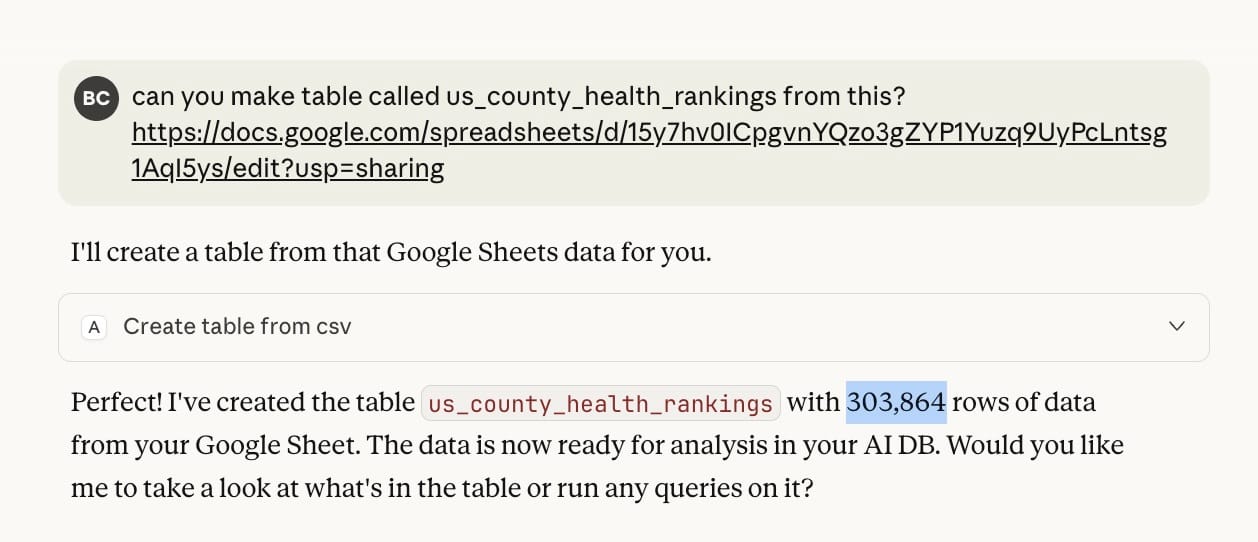
4. Get Question Suggestions
Here's the key step: Ask the AI to sample your data.
Say something like: "Sample this table and tell me what kind of analyses I can do with this data."
The AI will examine your columns, data types, and values, then suggest interesting questions.
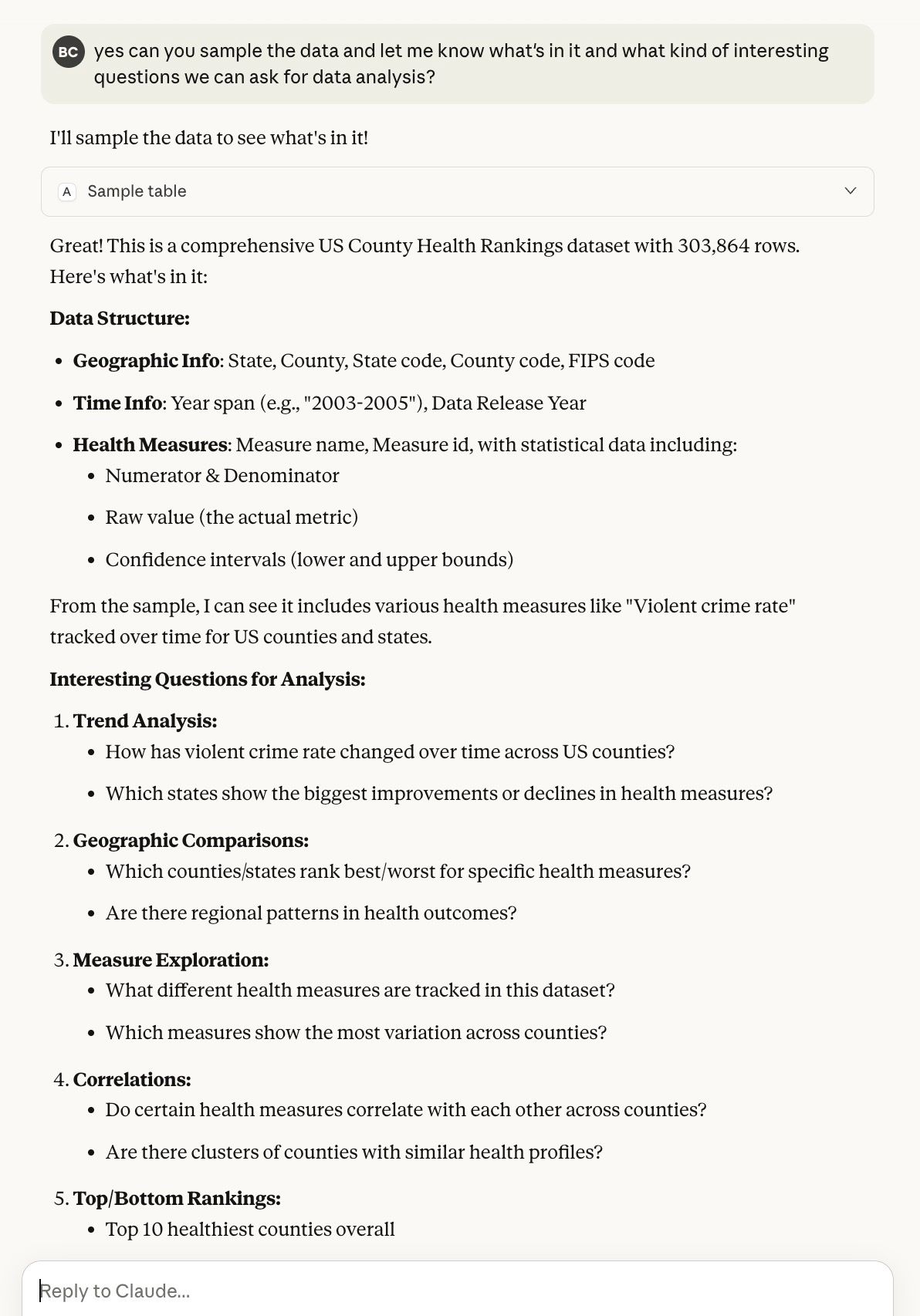
5. Start Analyzing
Pick a suggested question or ask your own. The AI writes SQL, queries your database, and gives you accurate answers.
Your data persists, so you can come back tomorrow and continue the analysis without re-uploading.
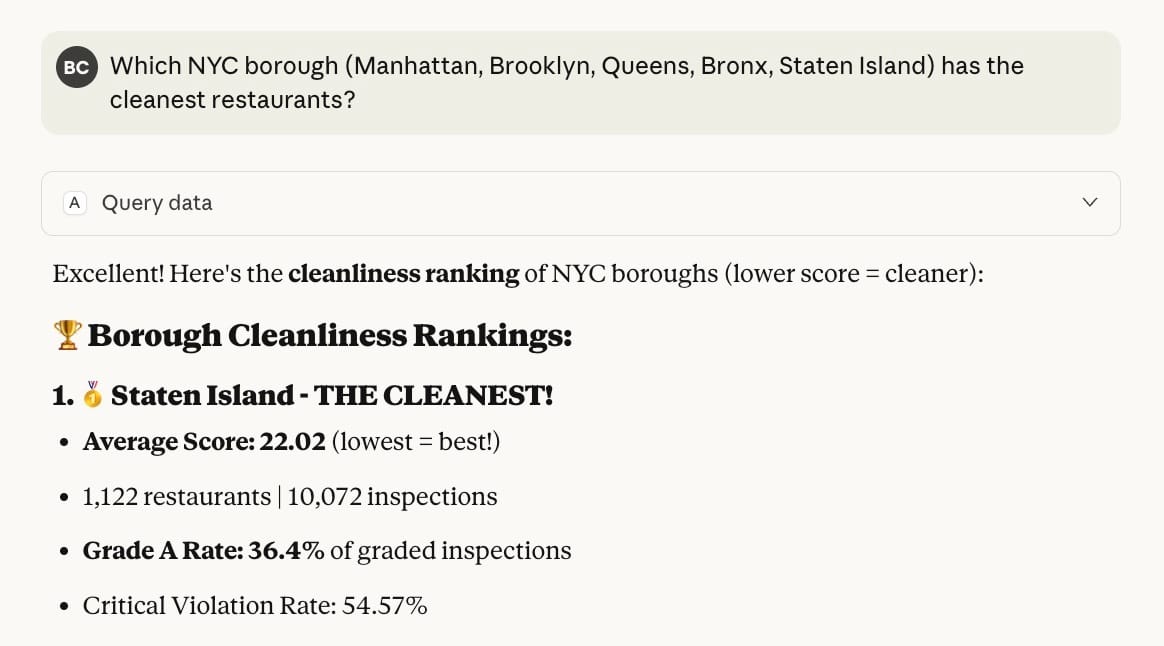
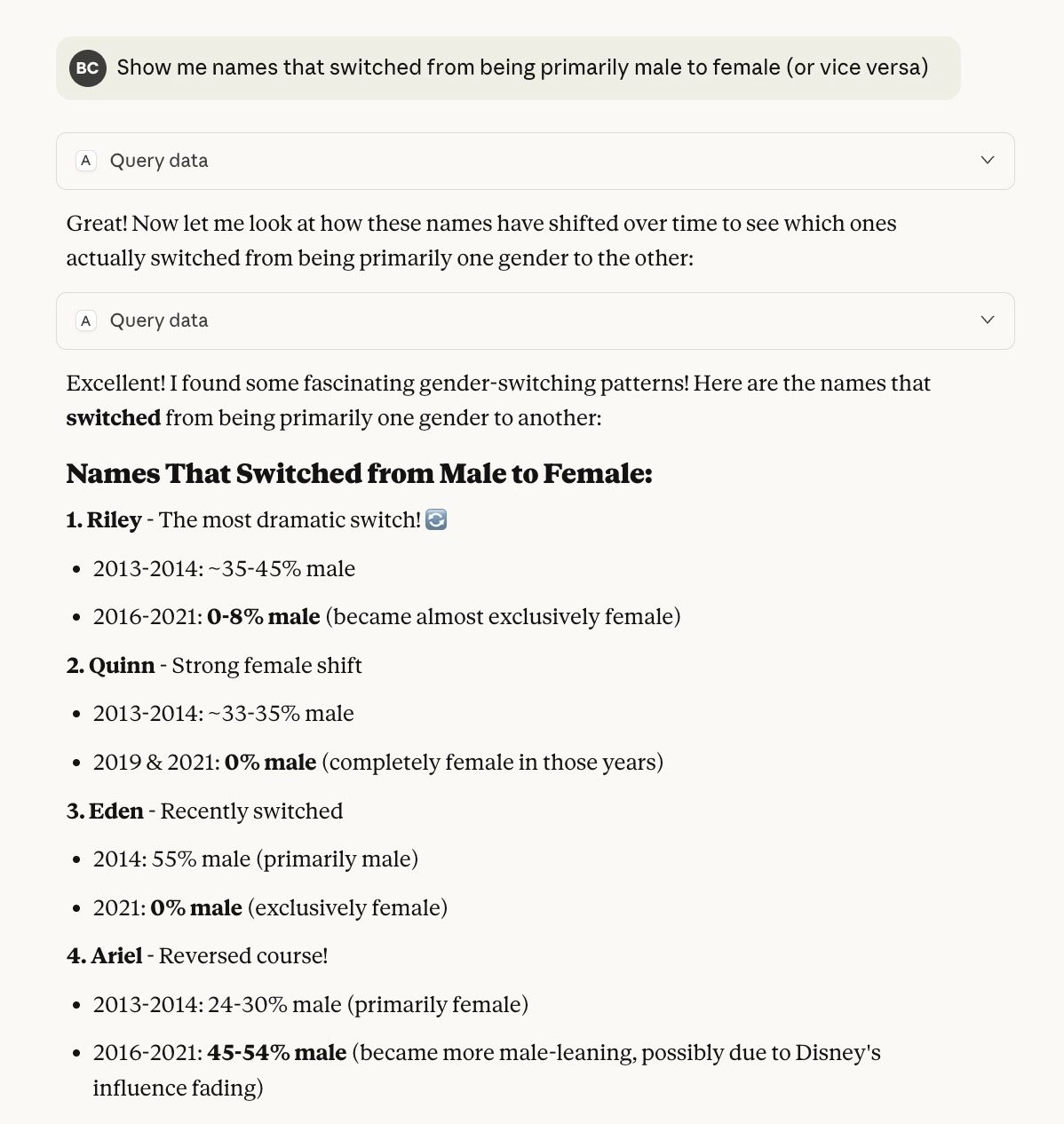
You can even create on the fly visualizations based on your data. Just ask ChatGPT/Claude and they’ll turn your data into charts.
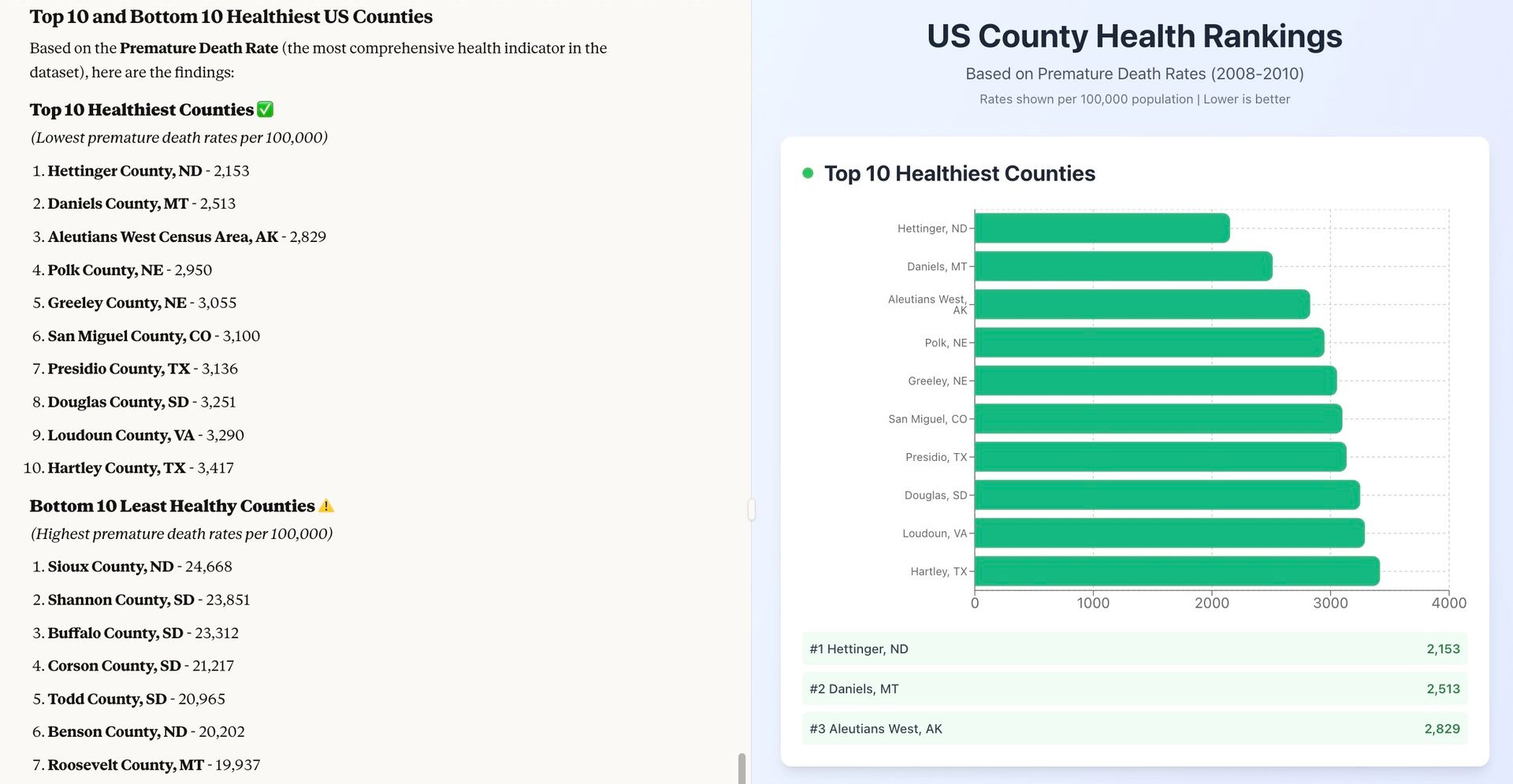
The Bonus Feature I Didn't Expect
Once your data is in a proper database, something magical happens.
The AI can sample your data and suggest questions you should ask.
You're not only getting better answers to your questions. You're getting better questions in the first place.
The AI looks at your data structure - what columns you have, what types, what patterns exist - and says "hey, based on what I'm seeing, here are some interesting analyses you could run."
This is huge. Even if you're experienced with data analysis, it's hard to think of every possible question. The AI sees relationships you might miss.
Upload sales data and it might suggest:
"You could analyze repeat purchase rates by product category"
"Looks like you have timestamp data - want to see hourly trends?"
"I notice correlation between these two variables - should we investigate?"
Questions you might not have thought to ask. But now you can just click and get the answer.
Real Use Cases
This works for any business data you're currently struggling to analyze:
Sales & Revenue:
Top products by revenue last quarter
Average order value by customer segment
Products with highest return rates
Customer lifetime value by cohort
Marketing Analytics:
Blended cost per acquisition across channels
Campaign ROAS comparisons
Month-over-month performance trends
Attribution modeling across touchpoints
Operations:
Inventory turnover rates
Fulfillment time by region
Support ticket trends by product
Seasonal demand patterns
Customer Analytics:
Churn prediction factors
Segment performance comparison
Email campaign conversion rates
Product affinity analysis
You can even combine multiple datasets. Upload your ad spend CSV and your orders CSV, then ask "what's my actual ROAS when I factor in returns?" The AI writes JOIN queries across both tables.
Why This Matters
Uploading CSVs to ChatGPT is easy. It's right there. Drag and drop.
But easy doesn't mean it works well.
And when you're making business decisions based on data analysis, the numbers need to be right.
Use AI the way it's meant to be used:
Let it understand your questions
Let it write the queries
Let a real database handle the data and computation
You'll get better answers. You'll save time. And you won't waste hours re-uploading files and debugging wrong numbers.
Plus, you get AI-suggested questions. That alone is worth the setup time.
Setup takes about two minutes. Link your data once, get suggestions for what to analyze, ask questions, get accurate answers.
If you’d like to try a/gentic’s AI DB reply to this email or DM Bora on LinkedIn.